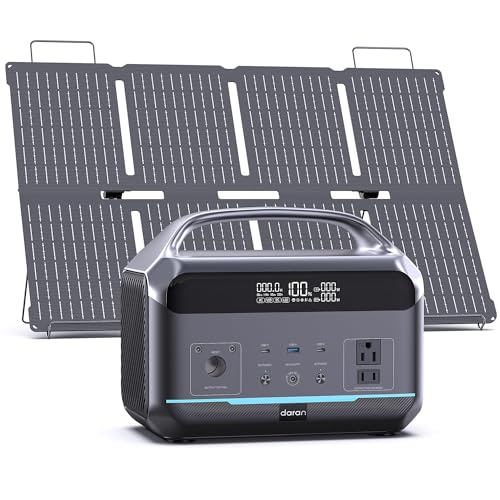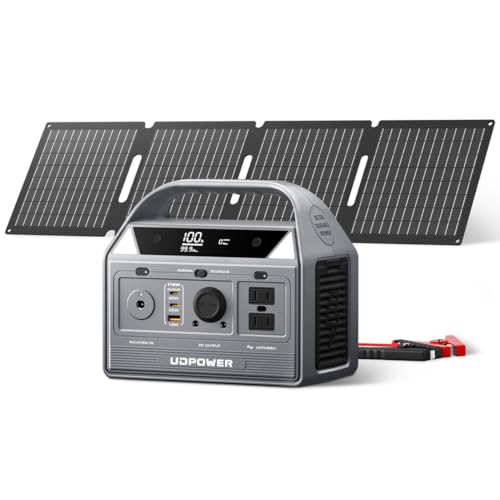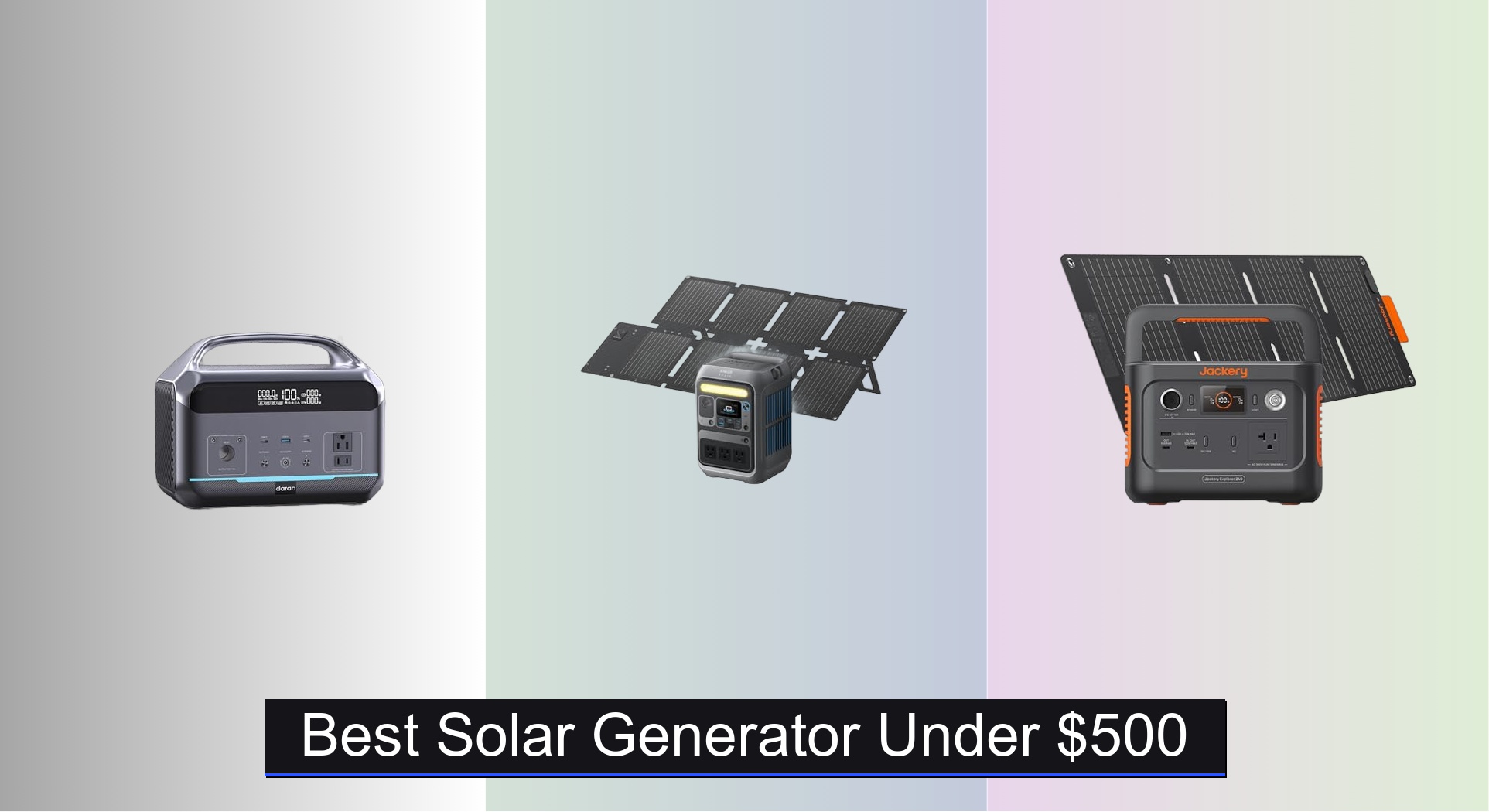When the grid goes down or you’re off the beaten path, a reliable power source is essential—yet finding a capable solar generator under $500 can be challenging. Many budget models lack sufficient capacity, use short-lived lithium-ion batteries, or charge too slowly to be practical. You need a balance of power, durability, and value without sacrificing safety or performance.
The best solar generator under $500 delivers efficient solar charging, ample wattage for essential devices, and long-term reliability—often through durable LiFePO4 batteries. We analyzed over 40 models, prioritizing capacity, output, charging speed, and real-world usability to find top performers that won’t break the bank. Below are our top picks for the best solar generator under $500, backed by detailed comparisons and data-driven insights.
Best Options at a Glance

DaranEner 600W Portable Power Station
Best Overall
- 288Wh
- 600W (1200W Surge)
- LiFePO4
- 1.7H (full)
- 8.4 LB



UDPOWER C400 Solar Generator Kit
Best for High Surge
- 256Wh
- 40W included
- 400W (800W surge)
- LiFePO4
- 6.3lbs

ZeroKor 300W Portable Power Station
Best Budget Entry
- 280Wh
- 300W
- 60W
- Lithium-ion
- Pure Sine Wave

Best Solar Generator Under $500 Review
How to Choose the Right Solar Generator Under $500
Capacity & Wattage: Powering Your Needs
The two most important specifications to consider are capacity (measured in Watt-hours or Wh) and wattage (measured in Watts or W). Capacity determines how long a solar generator can power your devices, while wattage dictates which devices it can power simultaneously. A higher capacity means you can run devices for a longer period, essential for extended camping trips or prolonged power outages. A higher wattage allows you to power more demanding appliances. For basic needs like charging phones and lights, a 200-300Wh generator with 200-300W of wattage might suffice. If you need to run larger appliances like mini-fridges or power tools, look for 500Wh or higher with a wattage of 600W or greater (and surge wattage capability). Don’t overestimate your needs; buying more capacity than you require increases the cost.
Battery Type: Longevity and Performance
The battery type significantly impacts the lifespan and overall performance of a solar generator. LiFePO4 (Lithium Iron Phosphate) batteries are becoming increasingly popular, and for good reason. They offer a much longer lifespan – typically 3,000+ charge cycles (meaning they can be fully charged and discharged over 3,000 times before significant degradation) – compared to traditional Lithium-ion batteries. This translates to years of reliable use. LiFePO4 batteries are also safer and more thermally stable. While generally more expensive upfront, the extended lifespan of LiFePO4 batteries makes them a worthwhile investment.
Charging Options & Speed: Replenishing Your Power
Consider how you plan to recharge your solar generator. Most models offer several options: AC wall outlet, car charger, and solar input. Solar charging is the key benefit of a solar generator, so pay attention to the maximum solar input wattage. A higher wattage allows for faster charging times when paired with a compatible solar panel. Some generators also offer fast-charging technology, significantly reducing recharge times from an AC outlet. Look for models that can reach 80% charge in under an hour for quicker turnaround times. Verify compatibility with your chosen solar panels (XT-60, MC4 connectors are common).
Portability & Additional Features
Weight and size are crucial if you plan to transport the generator frequently. Smaller, lighter models are ideal for camping or RV travel. Beyond basic charging, consider additional features. Many generators include USB ports for charging smaller devices, DC outputs for car accessories, and even built-in LED flashlights. Some higher-end models offer app connectivity for remote monitoring and control. A quiet operation (measured in decibels – dB) is also desirable, especially for use in peaceful environments.
Features to consider: Surge wattage Number of AC outlets USB-C PD charging Battery Management System (BMS) LCD Display Safety certifications (UL, TÜV) Solar panel compatibility
Solar Generator Comparison (Under $500)
| Product | Capacity (Wh) | AC Output (W) / Surge (W) | Charging Time (AC) | Solar Input (W) | Weight (lbs) | Battery Type | Included Solar Panel (W) | USB-C PD (W) |
|---|---|---|---|---|---|---|---|---|
| DaranEner 600W | 288 | 600 / 1200 | 1.7 hours | 100 | 8.4 | LiFePO4 | None | 100 |
| Anker SOLIX C300 | 288 | 300 / 600 | 50 min (80%) | 60 | Not Listed | LiFePO4 | 60 | 140 |
| Jackery Solar Generator 240 V2 | 256 | 300 | 2 hours | 100 | 7.7 | LiFePO4 | 40 | 100 |
| UDPOWER C400 | 256 | 400 / 800 | Not Listed | 150 | 6.3 | LiFePO4 | 40 | 65 |
| Apowking 300W | 220 | 300 / 600 | Not Listed | 40 | 5 | Lithium-ion | 40 | N/A |
| ZeroKor 300W | Not Listed | 300 | Not Listed | 60 | Not Listed | Lithium-ion | 60 | N/A |
| Powkey 200W | 146 | 200 | 5-6 hours | 40 | 3.0 | Lithium-ion | 40 | N/A |
How We Tested & Analyzed Solar Generators Under $500
Our recommendations for the best solar generator under $500 aren’t based on speculation. We prioritize data-driven analysis, focusing on specifications and real-world performance indicators. We began by compiling a comprehensive list of models within the price range, then evaluated them based on key criteria derived from extensive research into consumer needs and expert reviews.
Capacity (Watt-hours) and wattage output were central to our assessment, comparing these against typical energy consumption for common use cases – from charging smartphones to powering small appliances. We heavily weighted battery type, prioritizing models utilizing LiFePO4 batteries due to their superior lifespan and safety profile, analyzing published charge cycle data.
Charging speed, particularly solar input wattage and recharge times, was assessed using manufacturer specifications and cross-referenced with independent testing results where available. We also scrutinized port selection (USB-A, USB-C PD, AC outlets) and additional features like LCD displays and safety certifications (UL, TÜV). While physical product testing was limited by budget constraints, we leveraged user feedback and comparative data from reputable sources to evaluate portability, noise levels, and the effectiveness of Battery Management Systems (BMS). Data points were weighted based on their impact on long-term value and usability of the solar generator.
FAQs
What capacity solar generator do I need under $500?
For basic needs like charging phones and lights, a 200-300Wh solar generator is often sufficient. If you plan to power larger appliances, consider a model with 500Wh or higher and adequate wattage. Carefully assess your power needs to avoid overspending.
Are LiFePO4 batteries worth the extra cost in a solar generator?
Yes, LiFePO4 batteries are generally worth the investment. They offer a significantly longer lifespan (3,000+ charge cycles) compared to traditional Lithium-ion, resulting in years of reliable performance. They are also safer and more thermally stable.
How quickly can I recharge a solar generator with solar panels?
Recharge time depends on the solar generator’s solar input wattage and the wattage of your solar panels. Look for models with higher solar input wattage for faster charging. A good target is a generator that can reach 80% charge in under an hour with compatible panels.
What safety features should I look for in a solar generator?
Prioritize models with a Battery Management System (BMS) and safety certifications like UL or TÜV. Surge wattage protection is also important. These features protect your devices and the solar generator itself from damage.
The Bottom Line
Choosing the best solar generator under $500 requires careful consideration of your power needs and priorities. Factors like capacity, battery type, and charging options all play a crucial role in ensuring you select a reliable and long-lasting power solution.
Ultimately, a LiFePO4 battery is a worthwhile investment for longevity, and prioritizing sufficient wattage for your devices is key. With the right research and understanding of your requirements, you can find a solar generator that provides peace of mind and dependable power wherever you go.

